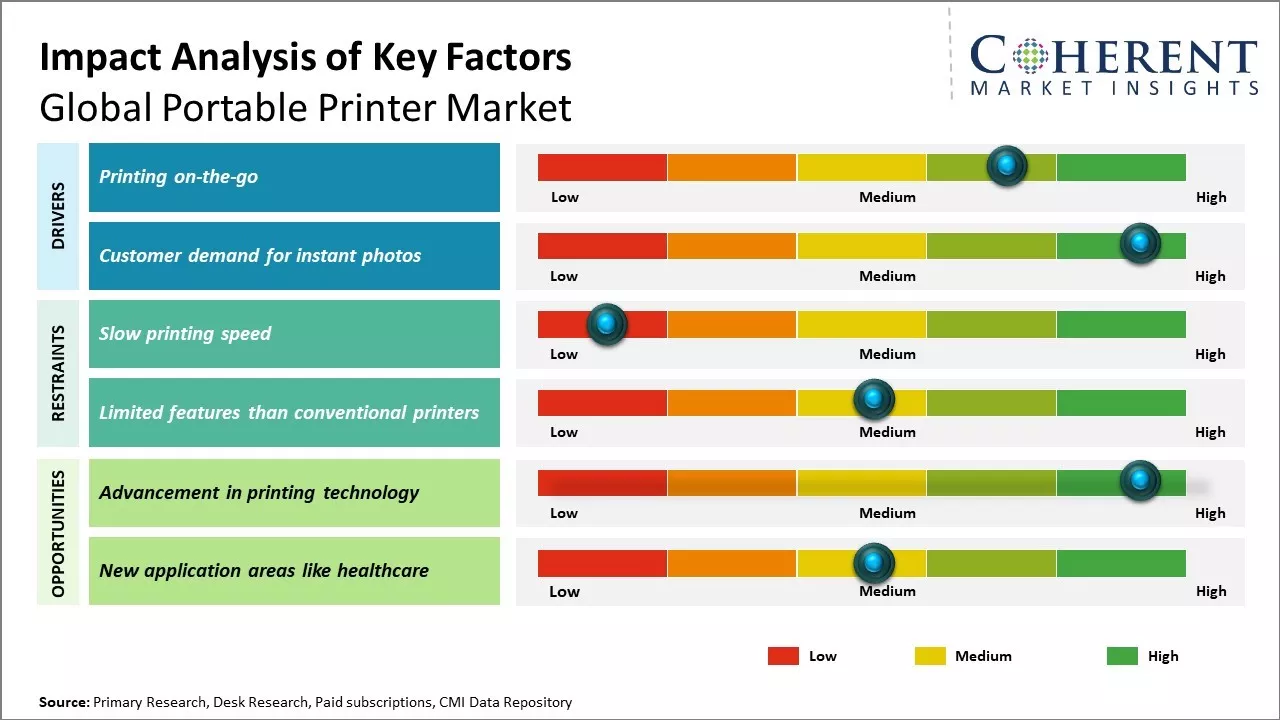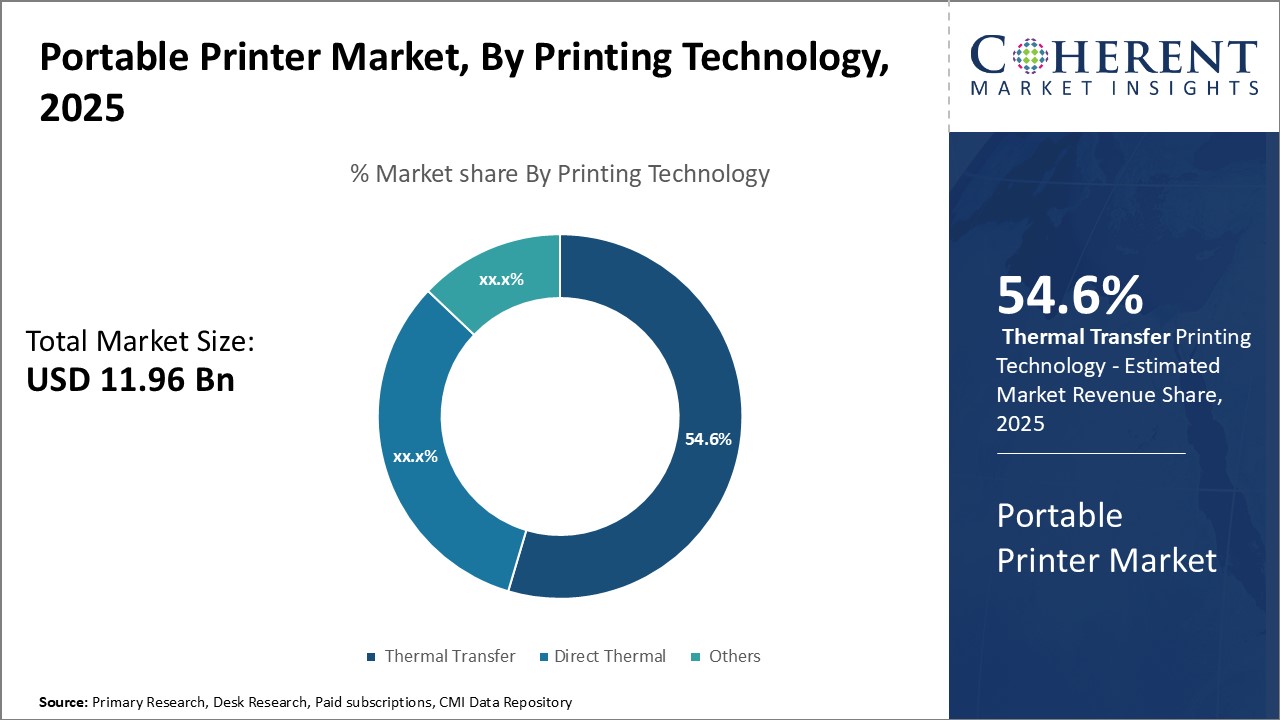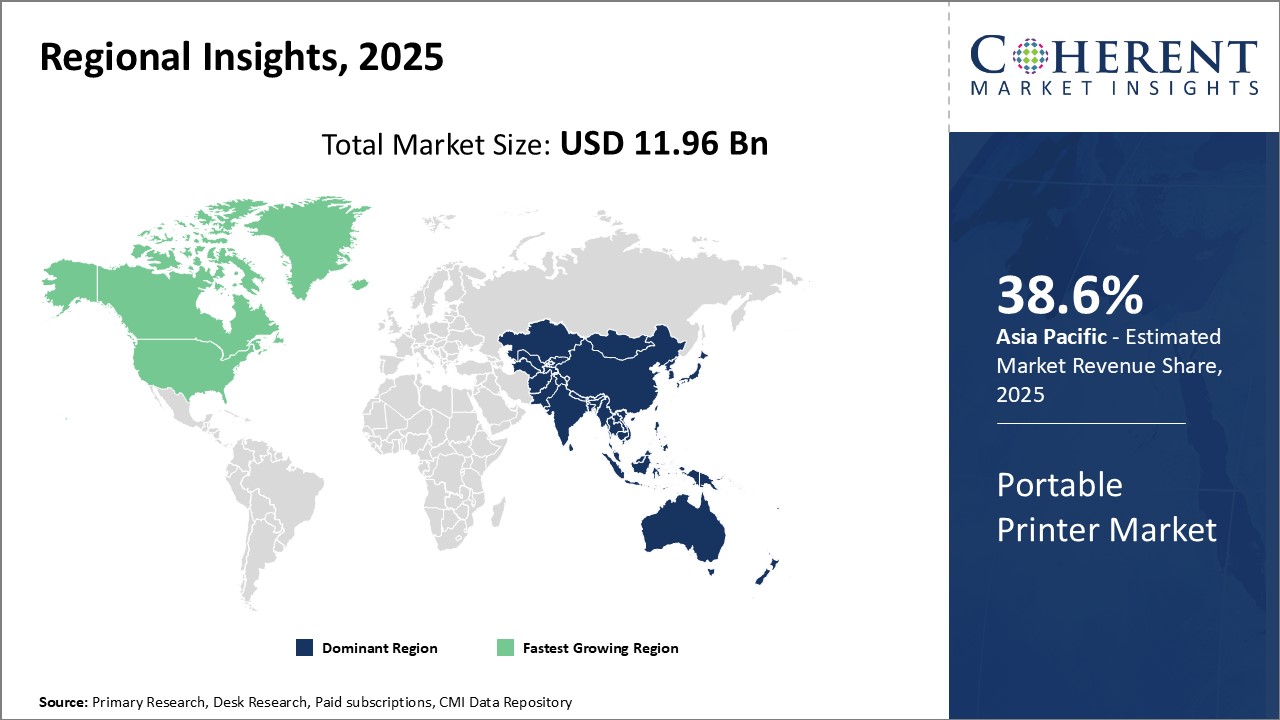The Global Portable Printer Market is estimated to be valued at US$ 11.96 Bn in 2025 and is expected to reach US$ 21.18 Bn by 2032, exhibiting a compound annual growth rate (CAGR) of 8.5% from 2025 to 2032.

Discover market dynamics shaping the industry: Download Free Sample
Portable printers allow consumers to print documents, photos, boarding passes and more on the go. Their compact design and wireless connectivity via Bluetooth and WiFi have made them especially popular for travelers and mobile professionals.
The portable printer market growth is driven by the increasing demand for wireless and portable printing solutions among users. Varied applications across different sectors like healthcare, retail, BFSI and hospitality have fuelled the demand significantly. Moreover, technological advancements enabling high resolution photo printing, lower power consumption, and stable wireless connectivity are bolstering the market growth. However, high initial costs and lack of standardization continue to limit the large-scale adoption of portable printers.
Growing popularity of Printing On-the-go
As lifestyles continue to become busier and more mobile, consumers are demanding the ability to print wherever they are. Portable printers allow users to print documents, pictures and more without needing to find a desktop printer.
This has been driven by the influx of tablets, smartphones and other mobile devices that are perpetually connected to WiFi or cellular networks. Users now generate more digital content and documents than ever on these devices throughout the day. However, that content still needs to be transformed from bits and bytes into physical hard copies from time to time, such as documents for work meetings, itineraries for travel, or photos from family events wanting to be printed and shared. Portable printers have become indispensable tools for outputting this digital content on the go.
In recent years, the evolution of portable printer technology has revolutionized the way professionals and consumers approach printing. Rather than being tethered to a stationary printer or relying on external printing services, the emergence of compact, battery-powered, and Bluetooth-enabled portable printers has transformed the printing landscape.
These portable models are designed to seamlessly integrate with the mobile devices that have become ubiquitous in our daily lives. By fitting easily into briefcases, purses, or backpacks, these printers offer true mobility, allowing users to access printing capabilities wherever they go. The dramatic reduction in size and weight of these portable printers has made them almost as compact and lightweight as the smartphones and tablets that people rely on daily.
The convenience of these portable printers is further enhanced by their ability to pair and print directly from mobile devices via Bluetooth connectivity. This instant, on-the-go printing functionality empowers professionals and consumers to address their printing needs without the constraints of traditional office or home-based printing setups.
The market has responded positively to the increased flexibility and convenience offered by portable printers. Consumers and businesses alike have embraced the value of being able to access print functionality from anywhere, recognizing the productivity and efficiency gains that this technology enables.

Get actionable strategies to beat competition: Download Free Sample
Customer demand for instant photos
Printing from smartphones has become a must-have feature driven strongly by the exploding demand for instant photo printing. With high resolution cameras now standard on even low cost mobile devices, people are taking more photos than ever before both personally and professionally.
However, digital photos lack the same sentimental, tangible qualities of printed hard copies that can be stored, shared, and displayed. Many customers want instant physical photos from their mobile devices to treasure memories from vacations, events, holidays, and everyday moments with loved ones. Portable printers have made it astonishingly simple to transform those digital files into attractive, wallet-sized snapshots on the spot.
Key Takeaways fromAnalyst:
The increasing demand for mobile printing from smartphones and tablets especially among millennials is a key growth driver. Technology advancements enabling wireless printing and connectivity of portable printers with multiple devices are expanding their uptake. The rising popularity of instant photography and demand for printing documents, receipts and photos on-the-go are additional growth prospering the market.
However, intense competition among vendors and pricing pressures may restrain market revenues to a certain extent. Issues with driver compatibility and support across different operating systems also challenge portable printer adoption. Furthermore, the market still largely relies on inkjet printing technology. High ink costs can discourage repeat purchases.
Looking regionally, Asia Pacific holds significant growth potential attributed to the proliferation of smartphones. China in particular stands to benefit from its huge manufacturing capacity and domestic demand. North America and Western Europe currently remain dominant, benefitting from high consumer spending on personal tech devices. Meanwhile, LAMEA (Latin America, Middle East and Africa) is set to emerge as a lucrative market supported by infrastructure development and increasing digitalization.
Overall, while pricing pressures and technical glitches need to be addressed, the tide appears to be turning in favor of portable printers led by improvements in print quality, speed and battery life.
Market Challenges: Slow printing speed
One of the major factors holding back the growth of the portable printer market is the slow printing speeds offered by most portable printers. While portable printers provide consumers with print-on-the-go capabilities, their printing is often an order of magnitude slower than desktop printers. For example, based on data from the International Digital Corporation (IDC) in 2022, the average printing speed of portable printers is about 5-7 pages per minute (ppm) compared to desktop printers which often print at 20 ppm or higher. This slow speed means printing even just a few pages takes a noticeable amount of time when using a portable printer. For consumers and business users who need medium to large volume printing, the wait time can be frustrating and non-productive.
The sluggish printing speeds have made portable printers unsuitable for many printing jobs and use cases where time is of the essence. For instance, travelers needing to print out boarding passes or task-related documents in a hurry at the airport are not able to rely on portable printers. Similarly, sales and support professionals wanting to quickly print materials for clients find portable printers too slow. According to data from the World Travel & Tourism Council, the number of international tourist arrivals was 1.5 billion in 2020 but increased to over 4 billion in 2022 as mobility increased post pandemic. However, the slow printing speeds have prevented these portable printers from being widely adopted by these mobile professionals despite the growth in travel.
To boost adoption and growth, portable printer manufacturers need to focus on developing technologies that can significantly enhance printing speeds while still maintaining portability. Some options include using more efficient printheads and developing sophisticated packetization methods to process print jobs faster. Unless these speed issues are addressed, the potential of portable printers to gain bigger shares of the professional and high-volume personal printing markets will remain untapped, putting a ceiling on revenue growth potential for companies.
Market Opportunities: Advancement in printing technology
Advancements in printing technology will unlock tremendous opportunities in the global portable printer market in the coming years. 3D printing is emerging as a disruptive technology that could reshape manufacturing worldwide. The ability to print parts and products on demand will revolutionize numerous industries like healthcare, construction, automotive, and consumer goods. Portable 3D printers are already being developed and will enable on-site printing and decentralized manufacturing. This will provide more flexibility to businesses and boost productivity.
At the same time, the improvements in inkjet and laser printing technologies are enabling the creation of portable printers that are smaller, smarter and more versatile than before. New materials and methods allow printer manufacturers to design compact models that can print on various paper types and sizes. Some portable printers are also integrated with sensors and WiFi connectivity for scanning, copying and sending documents wirelessly from any location.
Sustainability is another area where portable printers are making a difference. According to a study by United Nations Environment Program about 8% of global greenhouse gas emissions are associated with paper production as of 2020. Portable printers equipped with features like double-sided printing, electronic document sharing are helping curb paper usage. They encourage digital documentation over physical files. This evolution towards paperless systems through portable connectivity solutions will be a major trend in the coming years as more businesses and governments adopt greener practices to achieve their climate change goals.

Discover high revenue pocket segments and roadmap to it: Download Free Sample
Insights By Printing Technology - Direct Thermal Leads Portable Printing Due to Operational Simplicity
Within the portable printer market segmented by printing technology, direct thermal is estimated to hold 54.6% share in 2025 owing to its uncomplicated functionality. Unlike thermal transfer printers which require ribbons, direct thermal models feature a simplified design that prints black on white using just thermal paper. This inherent ease-of-use facilitates on-the-go printing needs across diverse scenarios.
Direct thermal printers offer a distinct advantage in the portable printer market due to their intuitive one-step process, which minimizes user frustrations compared to the multi-step ribbon cartridge installation or replacement required by thermal transfer models. Their low maintenance operation is well-suited for fast-paced, mobile applications where downtime is unacceptable. Additionally, direct thermal printers eliminate the need for ribbon waste disposal, which can be an issue with thermal transfer units. This environmental friendliness and ongoing cost savings contribute to the continued popularity of direct thermal technology.
In mobile occupations such as delivery and transportation, where proof-of-delivery forms are essential, direct thermal is the preferred choice due to its ability to enable rapid yet reliable documentation. Signatures and details are clearly imprinted without the need for pre-printing, making it an ideal solution for in-the-field scenarios like emergency response. In these situations, direct thermal satisfies pressing printing demands through its instant-on, ribbon less convenience.
The simple load and print functionality of direct thermal makes it well-suited for frontline roles where technicians must focus on tasks rather than technology. Settings remain unchanged between uses, ensuring consistency for repeated forms. Overall, direct thermal dominates the portable printer market in terms of technology due to its ability to satisfy real-world requirements through an inherently intuitive, low-fuss operation.
Insights By End-use Industry - Transportation and Logistics Drives Portable Printing Needs
Among industries fueled by portable printing, the transportation and logistics segment is estimated to account for 41.3% share in 2025. On-the-go documentation plays a vital role for efficiency in these mobile sectors. Proof-of-delivery receipts, dispatch notes, inventory lists, and other real-time records are indispensable.
Portable printers are essential for transportation and logistics operations due to their compact, rugged design that allows them to be easily integrated into delivery vehicles. These printers enable couriers to efficiently print address labels and capture signatures on-the-go, improving the overall delivery process.
Fleet managers also rely on portable printers to generate driver logs, consignment details, and maintenance reports from any location, enhancing fleet management and compliance. Warehouse staff performing stock checks or collection tasks can utilize portable printers to generate fully-functional documentation while in continuous motion, streamlining inventory management.
Furthermore, portable printers facilitate proof-of-pickups, waybills, and customs forms for international freight handlers, matching the transit environments that require time-critical paperwork generation away from fixed offices. Retail inventory replenishment also depends on on-site stocktaking guided by portable printing solutions.
In summary, the transportation and logistics industry has been at the forefront of portable printing adoption due to the inherently dynamic nature of their workflows, where workers remain on the move throughout document-intensive processes. Portable printers empower seamless tracking and accountability, driving efficiency across these industries.

Need a Different Region or Segment? Download Free Sample
The Asia Pacific region is estimated to hold 38.6% share of the global portable printer market in 2025. Countries like China, India and Japan have seen a rapid increase in international trade activities which has augmented the need for portable printing at various stages of supply chain management. For example, portable printers are highly utilized in inspection, documentation, and invoicing purposes at factories, warehouses, and transportation centers. The thriving e-commerce industry in the region has also created opportunities for the use of portable printers for labeling shipments directly from distribution vehicles. Having a dominating share in global manufacturing has made Asia Pacific an attractive market for portable printer brands to expand their regional presence. In addition, the rising disposable incomes and increasing acceptability of technology-based conveniences will continue driving the APAC portable printer market upwards in the coming years.
Another noteworthy region is North America which has emerged as the fastest growing market for portable printers globally. The presence of major portable printer manufacturers such as HP, Canon, and Brother have established the U.S. as a key manufacturing hub which caters to both domestic as well as international demand. Furthermore, the high percentage of mobile workers and consumers in the U.S. and Canada has boosted the adoption of portable printers in the past decade. Companies provide employees with portable printing solutions to enable mobility and productivity even while travelling or working remotely.
Portable Printer Market Report Coverage
| Report Coverage | Details | ||
|---|---|---|---|
| Base Year: | 2024 | Market Size in 2025: | USD 11.96 Bn |
| Historical Data for: | 2020 To 2024 | Forecast Period: | 2025 To 2032 |
| Forecast Period 2025 to 2032 CAGR: | 8.5% | 2032 Value Projection: | USD 21.18 Bn |
| Geographies covered: |
|
||
| Segments covered: |
|
||
| Companies covered: |
Bixolon Co. Ltd, Brother Industries Ltd., Canon Inc., Citizen Systems Japan Co., Epson, Fujitsu, Hewlett Packard Enterprise Development LP, Honeywell International Inc., Oki Data Americas, Inc., Polaroid Corporation, Printek LLC, Sato Holdings Corporation, Seiko Epson, Star Micronics Co., Ltd., Toshiba Tec Corporation, ZEBRA Technologies |
||
| Growth Drivers: |
|
||
| Restraints & Challenges: |
|
||
Uncover macros and micros vetted on 75+ parameters: Get instant access to report
*Definition: The global portable printer market consists of portable printing devices that are compact, lightweight and equipped with rechargeable batteries, allowing users to print documents and photos on the go. These portable printers are able to connect with smartphones and tablets via Bluetooth or Wi-Fi and print wired or wirelessly from various mobile devices. They are useful for printing e-tickets, boarding passes, documents and photos while traveling or in situations where a desk-based printer may not be accessible. The global portable printer market includes products from major brands like Canon, HP, Epson, Brother, and more.
Share
Share
About Author
As an accomplished Senior Consultant with 7+ years of experience, Pooja Tayade has a proven track record in devising and implementing data and strategy consulting across various industries. She specializes in market research, competitive analysis, primary insights, and market estimation. She excels in strategic advisory, delivering data-driven insights to help clients navigate market complexities, optimize entry strategies, and achieve sustainable growth.
Missing comfort of reading report in your local language? Find your preferred language :
Transform your Strategy with Exclusive Trending Reports :
Frequently Asked Questions
Joining thousands of companies around the world committed to making the Excellent Business Solutions.
View All Our Clients